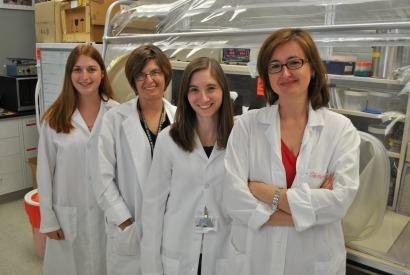
Gemma Reguera, MSU microbiologist, has developed bioelectrochemical systems known as microbial electrolysis cells, or MECs, using bacteria to breakdown and ferment agricultural waste into ethanol. Reguera’s platform is unique because it employs a second bacterium, which, when added to the mix, removes all the waste fermentation byproducts or nonethanol materials while generating electricity.
Similar microbial fuel cells have been investigated before. However, maximum energy recoveries from corn stover, a common feedstock for biofuels, hover around 3.5 percent. Reguera’s platform, despite the energy invested in chemical pretreatment of the corn stover, averaged 35 to 40 percent energy recovery just from the fermentation process, said Reguera, an AgBioResearch scientist who co-authored the paper with Allison Spears, MSU graduate student.
“This is because the fermentative bacterium was carefully selected to degrade and ferment agricultural wastes into ethanol efficiently and to produce byproducts that could be metabolized by the electricity-producing bacterium,” Reguera said. “By removing the waste products of fermentation, the growth and metabolism of the fermentative bacterium also was stimulated. Basically, each step we take is custom-designed to be optimal.”
The second bacterium, Geobacter sulfurreducens, generates electricity. The electricity, however, isn’t harvested as an output. It is used to generate hydrogen in the MEC to increase the energy recovery process even more, Reguera said.
“When the MEC generates hydrogen, it actually doubles the energy recoveries,” she said. “We increased energy recovery to 73 percent. So the potential is definitely there to make this platform attractive for processing agricultural wastes.”
Reguera’s fuel cells use corn stover treated by the ammonia fiber expansion process, an advanced pretreatment technology pioneered at MSU. AFEX is an already proven method that was developed by Bruce Dale, MSU professor of chemical engineering and materials science.
Dale is currently working to make AFEX viable on a commercial scale.
In a similar vein, Reguera is continuing to optimize her MECs so they, too, can be scaled up on a commercial basis. Her goal is to develop decentralized systems that can help process agricultural wastes. Decentralized systems could be customized at small to medium scales (scales such as compost bins and small silages, for example) to provide an attractive method to recycle the wastes while generating fuel for farms.
[Inset: MSU microbiologist, Gemma Reguera (first from right) and colleagues]
For additional information:
MSU Microbiology & Molecular Genetics

